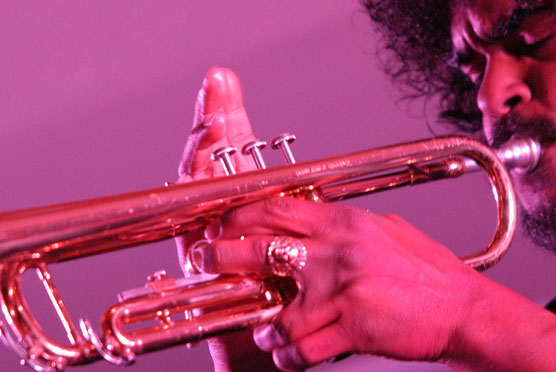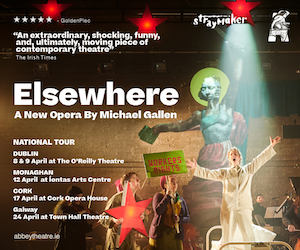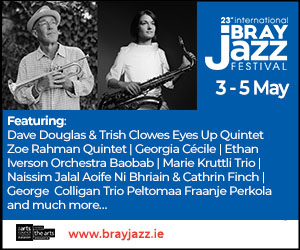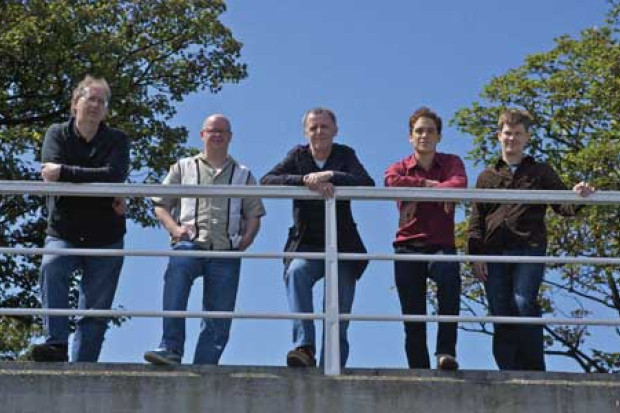
Photo: Robert Goode
Think Global, Play Local
Some commentators are asking whether the ‘festivalisation’ of jazz has contributed to the decline of the club scene, the traditional lifeblood of the working musician. In the summer season particularly, hundreds of jazz festivals worldwide compete for our attention, many of them featuring headline acts that are not jazz by even the loosest definition. Is there a danger that the pursuit of marketing opportunities is endangering grassroots development of the music?
As the Bray Jazz Festival proved over the May bank holiday weekend, it’s all about getting the balance right. Carefully planned, a good festival will leverage a critical mass of attendees to attract solid international acts, while at the same time supporting the best of local music. And the programming is crucial: while it is often commercially necessary to include bands that may have purists shaking their heads, the seriousness of music has to be the core criterion. The right musical mix will enlighten as well as entertain, and expand rather than diminish serious audiences on the club circuit.
Now in its ninth year, Bray has emerged as the leading Irish jazz festival after Cork, a position it has earned through a combination of the Improvised Music Company’s thoughtful programming and the tireless management of organisers George and Dorothy Jacob. After several years of headlining with Americans, this year’s event had a distinctly European cast. True, US funk legend Maceo Parker had them dancing in the seatless Mermaid Arts Centre on the Saturday night, but otherwise it was primarily a pan-European affair, with a sprinkling of other global acts and, most importantly, an unprecedented range of the best in Irish jazz.
The French accordionist Richard Galliano, a frequent visitor to Ireland, arrived at the Mermaid on Friday night with the chamber jazz trio Mare Nostrum, which presented a set of subtle and exquisite compositions drawn from disparate sources: French chansons, Italian waltzes, tangos, a Swedish folk song, even a Monteverdi madrigal. Joined by the pianist Jan Lundgren and the Sardinian trumpet and flugelhorn player Paolo Fresu, Galliano was the focal point of a very refined programme of tunes that, though rooted in traditions far from the jazz mainstream, were played with great jazz feeling.
If he played a majority instrument, Galliano would be more widely recognised for what he is – one of the world’s greatest improvisers. That his bandmates matched his creativity is evidence of this trio’s high level of collective musicianship: mesmerising unison lines played by Galliano and Fresu; pointillist piano runs from Lundgren; a democratic mix of fine writing, including Fresu’s ‘Valzer Del Ritorno’, Lundgren’s ‘The Seagull’ (inspired by Chekhov) and Galliano’s new-musette gem ‘Liberty Waltz.’ It was an enchanting performance.
At the other extreme was the Sunday show at the Mermaid, which featured songs from a rhythmically dynamic band, popular many decades ago and famous for their big, riff-based sound, creative soloing and huge debt to the blues. Count Basie? Try Led Zeppelin. Put in those terms, it is easier to see why the venerable French Orchestra National de Jazz risked offending purists with a programme of jazz versions of ‘Dazed and Confused,’ ‘Black Dog’, ‘Kashmir’ and other songs by the iconic rock band. By preserving the spirit of the originals while unearthing their roots for the basis of its interpretations, the ONJ’s eclectic performance was both sparkling tribute and musical tour de force.
Outside the Box
Away from the flagship venue, the festival offered such depth and diversity that fans were often forced to choose between equally attractive musical options. The Heather House Hotel, Katie Gallagher’s and Bray Town Hall were busy all weekend. Though challenged by poor acoustics and obstructed sightlines, the Royal Hotel Jazz Club also had a full programme, including two innovative free afternoon shows that were very well attended.
Unfortunately, Dafnis Prieto’s Latin sextet at the Royal, coming on the heels of Mare Nostrum’s sublime performance, sounded brash and one-dimensional. Prieto’s drumming technique is explosive, but it would be nice to see him in a more diverse context. The Danish a capella ensemble Touche and Liu Fang, a virtuoso on the Chinese lute, attracted full houses, and Ibrahim Electric, the let-it-rip Danish organ trio introduced to Dublin audiences at IMC’s 12 Points! festival last March, rivalled Maceo Parker with its infectious grooves and swamp-rock sounds.
But Irish-based performers provided the festival’s most innovative music, challenging listeners with small-group and large-ensemble performances that pushed the boundaries of the jazz tradition while searching globally for fresh musical models.
Influenced by the eclecticism of artists like Jaki Byard and Paul Motian, Togetherness, at the Royal on Saturday night, played original compositions by leader Justin Carroll and drummer Sean Carpio that combine complex melodies with driving rhythms and frequent shifts of mood. The result was both forceful and reflective, with solos from the leads, Carroll on piano and Michael Buckley on saxophones, that built expertly on the challenging rhythms of the writing. Carpio’s assured drumming and Simon Jermyn’s unusual bass lines, often mirrored by Carroll’s left hand, pushed the tunes along with power and confidence.
‘Three Dot Syndrome’, ‘Outside the Box’ and an unnamed new tune were fine examples of a contemporary compositional style that leans towards intricate form and irregular metres, while ‘The Paper Trail’, with a chord progression reminiscent of ‘Giant Steps’, and ‘Feel Good Factor’ showed that this very promising new band can swing with straight-ahead ease when it wants to.
Barely two hours after their Royal gig, Carroll, Buckley and Carpio were onstage again at the Heather House Hotel, joining Ronan Guilfoyle, Tommy Halferty and trumpeter Paul Williamson for a late-night exploration of Miles Davis’ electric period of the late sixties/early seventies. In albums like In a Silent Way and BitchesBrew, Davis created brooding, evocative music that could also be incredibly delicate. Revolutionary at the time, it has maintained its freshness across the decades, especially as presented by this exceptional group of musicians, who took full advantage of Davis’ mastery at creating improvisational settings. Williamson and Buckley traded several fiery exchanges, and Tommy Halferty’s guitar runs, while uniquely his own, captured expertly the spirit of John McLaughlin. It was also great to hear Guilfoyle playing electric bass, as opposed to amplified acoustic, particularly on pieces that depend so thoroughly on its forceful pulse.
Halferty also played in a very different context when he accompanied Norma Winstone at Bray Town Hall. With the minimum of rehearsal, this duo delivered a perfectly paced blend of standards and originals that showcased Winstone’s great skill as lyricist, interpreter of popular song and improviser. Tom Waits’ ‘San Diego Serenade’ and Kenny Wheeler’s ‘Old Times’ (retitled ‘How It Was Then’, with lyrics by Winstone) give some idea of the range of this set, which climaxed with John McLaughlin’s ‘Little Miss Valley’, a thrilling, wordless blues dialogue between voice and guitar. Winstone is a worthy model for the current crop of young Irish singers, including Cormac Kenevey, who was in fine form at the Royal as he showcased songs from his new album (see the review elsewhere in this issue).
Larger Irish ensembles were also well represented in Bray, with a spicy global mix of sounds from Yurodny, Havana Son and Francesco Turrisi’s latest cross-cultural group, Zahr. Fuzzy Logic’s afternoon gig at the Royal, where the band was joined by British trumpeter Tom Arthurs, was a tight, engaging display of challenging pieces by leader and composer Dylan Rynhart. Rynhart prefers the term ‘orchestral jazz’ to describe the band’s music, reflecting his investigation of a sound range outside the big-band tradition. Tunes like ‘Reflected Reasoning’ and ‘Spin Cycle’ are extended, segmented pieces that offer intriguing textures – a unison line of voice and guitar, say, against a march of horns and Hammond organ – that constantly surprise and yet are always organic to the structure of the piece. The band was powerful and well-rehearsed, with notable contributions from all, especially Arthurs and alto saxophonist Nick Roth. Guitarist Joe O’Callaghan, drafted late to replace Lee Tobin, played superbly.
With such a successful balance of Irish and international musicians, an obvious commitment to quality, and an impressive track record, the Bray Jazz Festival deserves a higher profile. If this year’s event is any indication, it is continuing to move from strength to strength, and should have all us of already marking our calendar for next year.
Published on 1 July 2008
Kevin Stevens is is a Dublin-based novelist and writer on history, literature, and jazz.

















